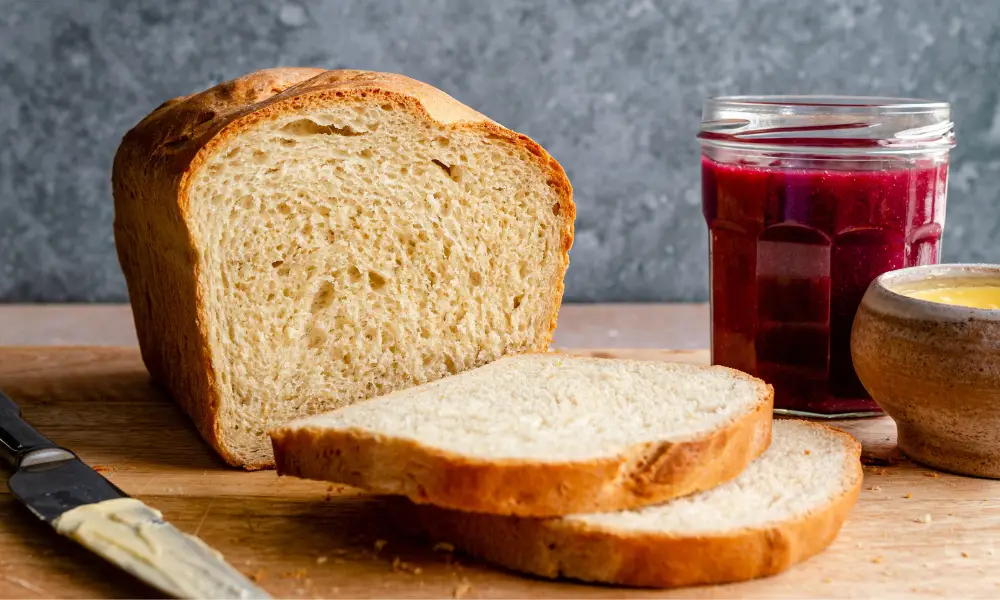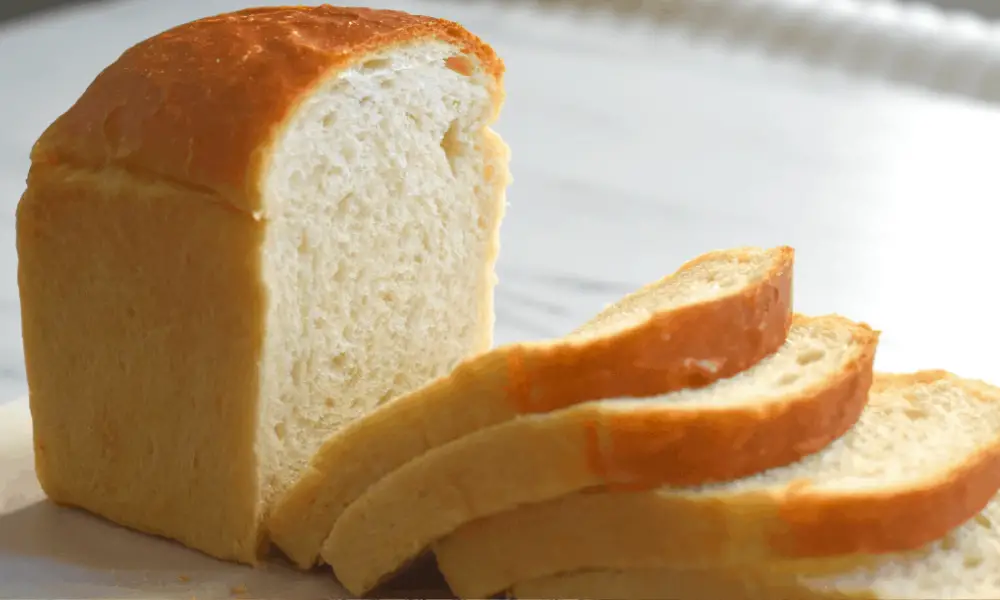If you want to prolong the life of your bread, you need to know how to freeze bread effectively. You can do it by sealing it using twist ties or plastic clips. Here are some tips to prolong the life of any loaf of bread. Just follow these instructions to avoid freezer burn and extend the freshness of any loaf of bread. Just be sure to take care when freezing bread to prevent it from turning stale. You can also toast it or reheat it to bring it back to life.

How to Freeze Bread Effectively?
For a variety of reasons, freezing food is a wise decision. You can keep bread fresh if you freeze it properly, and it can go without being used for months. This advice applies to excellent homemade loaves (like those prepared from this basic bread recipe) and store-bought varieties.
Step 1: Prepare Your Bread
Let your bread thoroughly cool after baking. This will keep it from becoming wet or growing mold. Each loaf should be carefully wrapped in plastic. Then cover it with freezer paper or foil. Your secret weapon for freshness is the double-wrap.
Using only the slices you want to use at a time will save you time and energy, so slice your bread before freezing.
Step 2: Put it in the Freezer
Before freezing, permanently mark the date on your bread. Bread should ideally be used from the freezer within six months; if you wait much longer, the bread can develop freezer burn.
Tips:
- Slice your loaves of bread before freezing them if it takes you a while to finish one. This will enable you to extract precisely what you need.
- Baking multiple loaves of bread at once and freezing the surplus will save you time.
- Making all of your bread and rolls a few weeks before your guests arrive and freezing them will help you jump-start preparing your holiday meal. Then, thaw them overnight in the refrigerator and reheat them before serving.
- Instead of baking finished loaves, freeze bread dough. You can always have freshly baked bread, which will take up less room. Even frozen, you may bake it in the oven. Keep an eye on your bread as it approaches the conclusion of the baking period, and add more time as necessary. You could discover that baking requires up to an additional 15 minutes.
How to Thaw the Bread?
Toast can be made with frozen bread that has been thawed. Take some set bread pieces out of the freezer and cook them in the toaster. However, you might need to adjust your toaster’s setting slightly higher than you would if you were toasting conventional bread.
The frozen bread you want to use can also be removed and thawed overnight on the countertop. The following morning’s meal should be prepared!
Don’t panic if you discover that your frozen bread has been sitting in the freezer for too long. Stale or a little dry bread works well for croutons, bread pudding, and French toast. Keep it from being wasted!
How Long is Bread Good For?
It depends on the type of bread and the storage method. The best way to preserve bread is in the freezer or at room temperature. Although it may seem contradictory, storing your bread in the refrigerator will hasten its deterioration.
Stored tightly in their original packaging at room temperature, packaged loaves from the grocery store should remain edible for three to seven days beyond the written best-by date. Bread produced at home or purchased from a bakery won’t likely survive as long; often, they lose its best qualities after two or three days.
What are the Alternative Uses for Extra Bread?
You can also use your leftover bread to make breadcrumbs or croutons if you don’t want to take up much room in the freezer. They’ll be far tastier since you can tailor them to your preferences, and as long as you dry them properly, they’ll be just as shelf-stable as the version you buy from the shop.
Another excellent option to use extra bread is to make bread pudding, which takes a few minutes to put together and can be prepared in the oven or crockpot. Additionally, it’s a simple way to finish up eggs that are about to expire.
Buy day-old bread from a bakery outlet store and put it in your freezer. You’ll spend roughly 75% less than you would in the supermarket.
What are the Different Types of Bread?
Banana Bread
Zucchini bread might be included in this group. Zucchini and banana bread are decadent, moist, sweet pastries typically chemically leavened using baking soda or baking powder. These “fast” bread are thought to have originated in the United States, where bakers in the 18th century utilized pearlash, a refined type of potash, to produce carbon dioxide in the dough. More Americans than any other bread type now look up recipes for banana bread online. Since it is so well-liked, February 23 has been designated National Banana Bread Day.
Baguette
The baguette is the only member of the bread family that evokes images of the Eiffel Tower and all things French in the same way, not even the delightfully flaky croissant. Due to its French heritage, the long, stick-like loaf is also known as French bread. Flour, yeast, water, and salt are used to make it. The legendary baguette, characterized by its chewy crust, feather-light inside, and topside slashes that permit gas expansion during baking, is created from these essential components.
Breadstick
Would it even be considered an Italian meal without a slice of this paper-thin, dry bread lying on the table as an appetizer? Breadsticks, much smaller than a baguette, are thought to have been created in the boot-shaped nation in the 17th century. These days, American restaurants will occasionally serve them warm and soft with cheese and garlic on top or as a dessert with icing and cinnamon.
Brioche
The French are primarily to thank for creating brioche, a typically sweet yeast bread stuffed with eggs and butter. The term “brioche” dates back to 1404, and people have enjoyed the golden, pillow-soft pastry ever since. It is frequently used to make dinner rolls, hamburger buns, and even French toast.
Can You Leave Freshly Baked Bread Outside Overnight?
Most freshly baked bread can be left out for a few days at room temperature without concern for mold growth or staleness. However, if you want to ensure that bread keeps fresh, it’s generally advisable to start storing it a little more cautiously, even in its initial stages. Some loaves last longer than others. Several artisanal bread recipes are called for ingredients that will delay the process of staleness.
Because the components in sourdough bread reduce the process of starch retrogradation, it keeps for longer (in which starch changes into moisture, evaporates, and leaves the bread dried out). To determine how long you can safely leave bread out at room temperature, look up how long that particular bread should last.
What are the Seven Simple Tips for Storing Bread?
It must be kept fresh if you intend to utilize bread for a prolonged time. Consider these easy suggestions for long-term storage:
- Do not refrigerate. Bread’s shelf life cannot be extended by refrigeration; if anything, refrigeration shortens the shelf life. This is because the moisture in your bread will evaporate as a result of your refrigerator, and the interior of the bread will thus become stale, dry, and difficult to chew. As an alternative, keep fresh bread in the freezer.
- Freeze bread. Bread should be frozen to maintain freshness for the longest time, and slices or whole loaves can be kept in freezer bags for up to two months. Your freezer, as opposed to your refrigerator, will maintain all the moisture in the bread itself. It will keep the same crisp outside and soft interior after defrosting and reheating, regardless matter whether you use a Dutch oven, toaster, or something else entirely.
- Only cut the bread when it’s required. The exposed interior releases moisture when you cut a loaf of bread open. You can store bread for longer if you leave the entire loaf whole until you’re ready to serve individual slices. After cutting the loaf open, store it in an airtight or nearly airtight container to create the impression that the crust still seals the bread’s interior.
- Conjoin the cut sides. Even while it could be preferable to retain an entire loaf intact for storage, it’s frequently not feasible. Try cutting your bread down the middle instead of the ends as you place it on the cutting board. Once you’ve cut what you need from the middle, you can press the sliced bread’s two sides together. You’ll be able to preserve more moisture inside the bread if you do this.
- Make use of stale bread. Sometimes it’s impossible to prevent the bread from going bad; in these situations, you can use the leftovers. You may use your stale bread in various ways, but breadcrumbs, croutons, and stuffing are common choices.
- Employ a bread box. You can prevent the bread from drying too quickly by storing it in a bread box. Between carefully wrapping bread and letting it out in the open at room temperature are bread boxes. They allow some air but are a dry, semi-sealed area to keep bread fresh.
- Wrap bread. Wrapping your bread will decrease air movement, preventing it from drying out. While paper and linen bread bags are choices, they don’t offer the same amount of security as plastic bags that have been appropriately sealed or aluminum foil that has been tightly wrapped. The safest solution might be to store bread wrapped in plastic.
What is Some Essential Bread Nutritional Information?
Calcium
Four medium slices of white bread per day would give more than 30% of the daily calcium intake that is advised to maintain strong bones and teeth. White bread is fortified with calcium.
Bread, particularly wholemeal bread, is a significant source of dietary fiber, which helps to maintain the health of our digestive system, control blood sugar and cholesterol levels, and prolongs our feelings of fullness.
Our bodies need protein for growth, renewal, and repair, and protein bread provides a low-fat supply of this essential nutrient.
Iron
Iron is added to white bread to fortify it. Iron is necessary for blood health, a robust immune system, energy, and focus.
Minerals & Other Vitamins
The B group vitamins thiamine (B1) and niacin (B3), crucial for releasing energy from meals and keeping healthy skin, eyes, and nails, are among the vitamins and minerals in bread. It contains the B vitamin folate (also known as folic acid), which is crucial for pregnant women because it can lessen the risk of birth abnormalities, including spina bifida.
Energy Bread has a low-calorie count. White bread has 77 calories per typical medium slice, whereas brown and whole wheat each have 72 calories.
Low-fat food is Fat Bread. White bread has 0.6g of fat per medium slice, brown bread has 0.7g, and whole wheat bread has 0.9g. Be cautious about what you add to it and stick to healthy toppings and spreads.
Sugar
Most bread is low in sugar, which is crucial for maintaining good teeth and a stable weight.
Conclusion
The first method involves using plastic clips or twist ties to seal the packages. These can be reused and are less effective at protecting baked products from moisture and air. Plastic clips tend to loosen inside the closure, which allows unwanted air to enter the product and cause staling. Moreover, the plastic clips have different colors, so you can quickly identify which day you baked bread. Regardless of choice, make sure to label the package as soon as possible so that customers can quickly identify it when it arrives.

